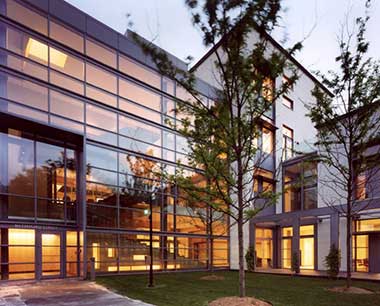
The preliminary results of the Demand Response Partnership Program (DRPP), a unique partnership launched by EDF and the U.S. Green Building Council (USGBC) in 2011, are now available in the 2013 DRPP Overview. Photo source: Harvard University.
Buildings account for 40% of our nation’s electricity use. In 2012, power plants spewed about 2 gigatons of global warming pollution into our air, which was about one-third of total U.S. emissions. That’s why EDF and the U.S. Green Building Council (USGBC) teamed up to launch the Demand Response Partnership Program (DRPP) aimed at increasing the participation from commercial buildings in host utility demand response (DR) and smart grid programs. Now, 2 years into the program, the preliminary results of this collaboration are available in our 2013 DRPP Overview.
DR is used to reduce energy use by rewarding utility customers who use less electricity during times of “critical,” peak electricity demand. Through DRPP, we leveraged relationships with the building community asking LEED projects to operate in low power mode when the grid is stressed. LEED ‘Pilot Credit 8: Demand Response’ has been developed as an incentive and implementation guideline.
This study evaluated three areas to measure the program’s success in 2013: Recruitment and outreach to potential participants, research and analysis of data from participants, and education about the DRP Program. A few key highlights are outlined in the Overview:
- Completed outreach to 572 LEED ‐registered and ‐certified buildings, representing 275 million square feet. Of these, 133 buildings (representing 51 million square feet) are enrolled, evaluating enrollment, or have been determined to be DR ready.
- Entered data analysis and reporting phase with a research pool of 30 buildings agreeing to provide energy usage data and nearly 200 buildings participating in the Building Systems Assessment Survey.
- Energy use data for 14 buildings, representing a total of 125 demand response events, were analyzed and this analysis will serve as a basis for future case studies.
USGBC & EDF partnered with select utilities, solution providers, and researchers to bridge the gap between the supply and demand sides of the energy grid. Southern California Edison (SCE) and NV Energy joined the team as utility hosts. Enerliance and MelRok are engaged as solution providers, with EDF and Lawrence Berkeley National Lab heading up the research arms of the program.
LEED Buildings Movement Leads the Way
According to the DRPP landing page on the USGBC website, “DRPP is part of a larger movement by LEED to get builders and architects to start thinking more holistically about their buildings and considering the interconnection between building systems. Demand response is another step in this tradition and focuses on thinking beyond the walls of the project to consider the interconnection between energy use decisions (how much and when it is used) and the impacts on energy generation and distribution capacity.”
With the launch of LEED v4, the newest update to the LEED green building program, what started as Pilot Credit 8: Demand Response has become a permanent part of the LEED rating system. The Demand Response credit rewards projects with 1-3 points towards LEED certification for ensuring their buildings are automated, DR-ready, and participating in programs if they are available.
Project registrations for the DRPP LEED credit have continued to pick up and now total over 300 across the country. Projects registered under LEED 2009 can still continue to use Pilot Credit 8: Demand Response.
More Results to Come
This year, DRPP will continue with data analysis and reporting, focusing on feedback surveys from commercial building participants and partners. EDF is examining the environmental impacts of demand response events by testing the premise that DR is both environmentally beneficial and key to increasing renewable generation.
The results of this analysis will be released in a final report in summer 2014. In the meantime, EDF will continue working with its DRPP partners to maximize the untapped potential of demand response to reduce carbon emissions, lower energy bills, and improve grid resiliency.









